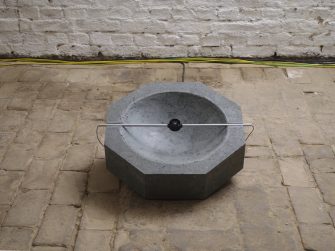26.10. — 17.11.2019
Opening: 25.10.2019 at 7 pm
!!! SPECIAL OPENING HOURS: THURSDAY, 21st NOVEMBER, 6 — 9 pm !!!
Raviv Ganchrow's sound installation »Westhafen Ground-Electric« in the cellar vaults of the ZK/U transforms the former warehouse building into a resonating chamber of its current industrial surroundings. The installation picks-up telluric currents from the ground outside the cellar and relays them in real-time into the vaulted hall. Characteristic frequency bands are extracted and spatially arranged to create walk-through zones of oscillating intensity.
The relationship between sound and space is a constant in Raviv Ganchrow's work, who studied both architecture (at the Cooper Union in New York) and sonology (at the Royal Conservatory in The Hague). Sound installations, theoretical writings, but also the development of sound generating technologies are important points in his work in the last years. In the process, material-specific attributes of space and sound are addressed and made tangible. Many of his more recent works deal with the intersection of natural and human-structured environments gauged in terms of their acoustic qualities and characteristics. Ganchrow often understands »places« as the sum of relationships that can be expressed in a triangular relationship »sound — space — observer« and involving frequency dependencies and their interconnections. One method that Ganchrow is currently exploring involves tapping into telluric currents in the ground. It is this specific electrical structure — combining earth currents with signals from Berlin's industrial harbour — that Ganchrow is employing in his »Westhafen Ground-Electric« installation.
Telluric currents are the on-going natural electrical fluctuations occurring in the earth's crust. They are dependent on, among others, geological formations, day-night cycles, natural radiation, ground water movements, lightning, mineral structures, but also on plants and the activities of soil organisms. These natural currents mix with anthropogenic currents — electric fields caused by industry, national power grids and transport infrastructure. In the vicinity of the ZK/U there are a number of different industrial sources that imprint in the telluric frequency bands: the Westhafen Port with its industrial and storage facilities, the railway and suburban railway lines passing here, metalworking industries and recycling companies and a power station. In addition historical residue from former uses, such as buried disused communication and power lines, iron debris and oil ground seepage all imprint effects on telluric current behaviour. In a preparatory process, Ganchrow monitored these currents at various points on the ZK/U terrain in order to install ground electrodes at critical locations in the ground, which are transmitting the currents live into an array of directional loudspeakers in the cellar vaults of the ZK/U.
These real-time telluric current streams form the basis of the sound installation. Ganchrow is not, however, concerned with a simple sonification of varying frequencies. Special filters and electro-acoustic procedures are employed to extract or isolate the frequency bands which are particularly characteristic of the site's environment and weave them into an ephemeral spatial tapestry in the cellar of the ZK/U. The low vaulted rooms of the ZK/U are divided into separate zones with the help of loudspeaker constructions between the arches. An audio system creates a spatia-sonic tapestry that visitors can gradually access as they walk about. The former railway warehouse at the Westhafen Port, that functions today as a cultural venue, sustain visible traces of its former functional fixtures, thus become a sounding board for invisible yet prominent fluctuations from its current industrial environment.
ZK/U -— Zentrum für Kunst und Urbanistik
Siemensstr. 27
10551 Berlin
Admission free
Opening Hours: Thu — Sun 2 — 7 pm
Organized by singuhr e.v. Funded by Initiative Neue Musik Berlin e.v. and Mondriaan Fund.
With the kind support of ZK/U — Zentrum für Kunst und Urbanistik.





